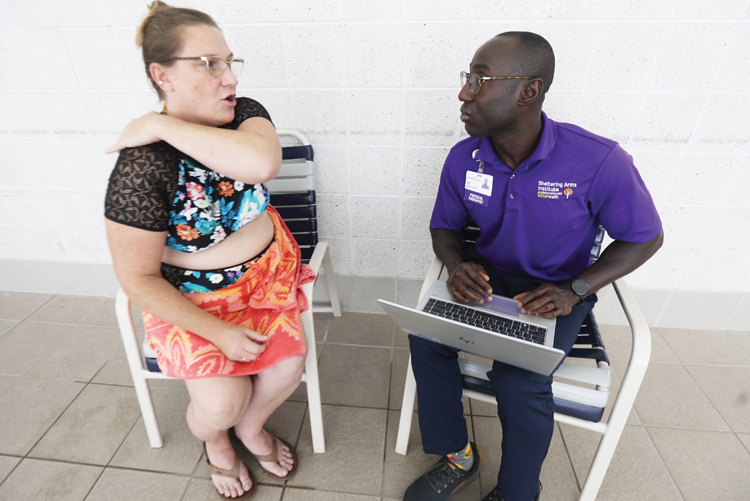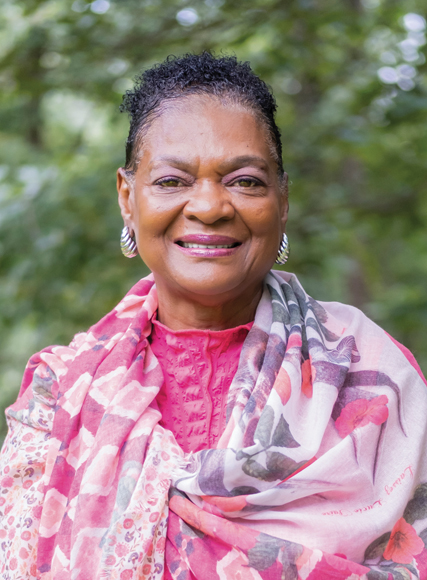Long COVID’s lasting impact on Richmond residents
George Copeland Jr. | 9/5/2024, 6 p.m.

Leslie Mento was working as a front line health worker and physical therapist in New York when the COVID-19 pandemic hit in 2020. He was among the first in the country to help patients suffering from long-term effects of the virus, a condition then known as post-COVID. Now based in Richmond, Mento continues his work with Long COVID patients at Sheltering Arms’ Bon Air clinic. His experience reflects how the lives of many have been reshaped by this persistent illness and the ongoing efforts to address its impact.
“We’re taking it bit by bit,” Mento said. “We’re getting better and better at it to some bit of degree.”
For Joy Hauser-Long, one of Mento’s physical therapy clients, Long COVID has been a rough adjustment. The 46-year old Blackstone resident’s illness was confirmed after multiple cases of COVID-19 and worsening symptoms in 2020 and 2022.
 Leslie Mento, right, a physical therapist at Sheltering Arms’ Bon-Air location is the lead for their Long COVID program. He helps Joy Hauser-Long, 45, of Blackstone, Va., July 30 with her long-term COVID issues.
Leslie Mento, right, a physical therapist at Sheltering Arms’ Bon-Air location is the lead for their Long COVID program. He helps Joy Hauser-Long, 45, of Blackstone, Va., July 30 with her long-term COVID issues.Hauser-Long has since taken several steps to address its effects, including work with an herbalist to manage her severe gastroparesis and changing her diet. The journey has taken its toll, but she is determined to build a new normal in her life.
“I’m hoping, and that’s all I can do, that’s why I continue, even on days when I don’t feel good,” Hauser-Long said. “I’m just continuing to say that I’m not done, I’m not finished trying.”
Chamberlayne Farms resident Edward Coleman has managed to stay positive despite a regression in his condition. His initial recovery from COVID-19, after his infection was discovered during a routine health check in 2020, defied expectations given his age, pre-existing health issues and the treatments available.
When interviewed for a previous story on Long COVID for the Free Press, Coleman had made multiple gains in his journey with the illness. This included dropping from six to three liters of oxygen for his breathing machine over a two-year period, regular walks through his neighborhood and returning to teaching his karate classes.
Now 80 years old, Coleman’s progress has stalled or reversed in some areas. He typically relies on five liters of oxygen when using a breathing machine daily. The karate classes he taught have paused and he is slowly restarting his walks around his neighborhood. Despite these setbacks, Coleman’s mood remains upbeat.
“His attitude hasn’t changed,” his wife, Charlene Warner Coleman, said. “He’s still kind and sweet and tries to help me as best he can. Can’t ask for any better.”
Coleman and Hauser-Long are some of the many in the United States impacted by Long COVID, which has remained under-discussed even as COVID cases have risen recently.
A report from the Centers for Disease Control and Prevention in February found that 6.4% of adults age 18 or older on average across the United States had experiences similar to Long COVID, with 5.4 to 7.1% of Virginia residents reporting similar experiences.
The knowledge gap around Long COVID due to the range of symptoms and limited research has been an ongoing problem for Mento and other medical professionals, stymying progress even as physical therapies adapt to the needs of patients.
“[There’s] still room for improvements,” Mento said. “It’s still worthwhile increasing knowledge and awareness on the clinician side of things to improve the care that we provide.”
The need for better support of Long COVID patients is a major concern for Hauser-Long, whose initial struggles were worsened by what she saw as the poor state of medical care in Virginia and lack of understanding around long COVID. It’s one legislators are attempting to address. Virginia Delegate Delores McQuinn has worked to balance advancing policy in this area, including the COVID-19 Remembrance Day holiday, while she, her daughter, Daytriel, and husband, Jonathan, also manage their own Long COVID symptoms.
 Delores McQuinn
Delores McQuinnWhile the effects of the illness have lessened since she first talked with the Free Press, McQuinn remains concerned about the financial and emotional toll for those affected by COVID-19, particularly in communities of color. With cases rising again, she spoke of the need to survey communities to both hear their concerns and keep people aware and protected.
“We could do much better as a state,” McQuinn said. “Some things [were] on the back burner, but now that it’s back in our face it’s important for us to look into it and to make sure that people are moving forward.”
U.S. Sen. Tim Kaine, whose mild Long COVID symptoms manifest as nerve tingling, also has been a consistent advocate for Long COVID policies and resources. He noted the need to standardize disability determinations used for Social Security benefits, along with more consistent funding for research and treatment.
 Tim Kaine
Tim Kaine“We’re making some progress, but not enough,” Kaine said. “The advocates in this space are not happy with the progress and I understand it.”
For his part, Coleman stressed the importance of COVID-19 measures like face masks, sanitizing and better ventilation for those living with Long COVID. He also noted the value of a positive, “winning attitude,” aided by the support of family and entertainment such as music, in adapting to a life altered by illness.
“That’s what you have to do,” Coleman said. “You have to make up your mind that you’re going to get better.”





